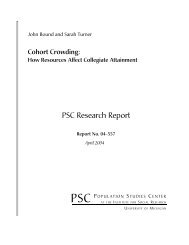Tracking metropolitan America into the 21st century - Population ...
Tracking metropolitan America into the 21st century - Population ...
Tracking metropolitan America into the 21st century - Population ...
You also want an ePaper? Increase the reach of your titles
YUMPU automatically turns print PDFs into web optimized ePapers that Google loves.
ResearchAs OMB’s suggestions indicate, oneimplication of <strong>the</strong> new <strong>metropolitan</strong>classification system is thatresearchers now have more choices.Under <strong>the</strong> old system, <strong>metropolitan</strong>researchers typically analyzed MSAstoge<strong>the</strong>r with ei<strong>the</strong>r CMSAs orPMSAs. The new system offersresearchers, at <strong>the</strong> local level, <strong>the</strong>opportunity to examine MetroSAs,metro divisions, CSAs, and MicroSAs.In addition, <strong>the</strong> growth of <strong>metropolitan</strong><strong>America</strong> has produced a greaternumber of MetroSAs than MSAs andPMSAs, and more <strong>metropolitan</strong> principalcities than central cities.A potentially expansive researchcommunity, including federal and stateagencies, nonprofit research organizations,and private-sector marketresearchers, will use <strong>the</strong> new <strong>metropolitan</strong>classifications. The federal statisticalagencies <strong>the</strong>mselves willinfluence <strong>the</strong> speed at which o<strong>the</strong>rresearchers move towards <strong>the</strong> new system,and <strong>the</strong> choices that researchersmake within that system. Some agencieslike <strong>the</strong> Bureau of EconomicAnalysis have already begun to releasedata that conform to <strong>the</strong> new <strong>metropolitan</strong>and micropolitan definitions.Many, like <strong>the</strong> Bureau of Labor Statisticsand <strong>the</strong> National Center forHealth Statistics, have yet to make <strong>the</strong>transition, in part because <strong>the</strong>ir mostrecent data releases pre-date <strong>the</strong> June2003 announcement of <strong>the</strong> new classificationsystem.The greater number of choices availableto researchers under <strong>the</strong> new systemmay carry both advantages anddisadvantages. On <strong>the</strong> one hand,researchers may now have access todata that conform more closely to <strong>the</strong>irgeographic areas of interest. On <strong>the</strong>o<strong>the</strong>r hand, as different <strong>metropolitan</strong>researchers choose to focus on differentclassifications, it may become moredifficult to compare across <strong>the</strong>ir findings.Some, as OMB suggests, maychoose to work with <strong>metropolitan</strong> divisionsfor comparability with PMSAs. 33O<strong>the</strong>rs may work with MetroSAsalone, or in combination withMicroSAs. Rural experts may focusonly on non-CBSAs, or on non-CBSAstoge<strong>the</strong>r with MicroSAs. This flexibilitycan enrich <strong>the</strong> field of inquiry, but itwill become even more important forresearchers to state <strong>the</strong>ir methodologyclearly and explain why <strong>the</strong>y have chosen<strong>the</strong>ir particular geographic frame.As discussed above, it is advised thatnational rankings of <strong>metropolitan</strong> areasand micropolitan areas employ <strong>the</strong>MetroSAs and MicroSAs, ra<strong>the</strong>r thanCSAs or <strong>metropolitan</strong> divisions.Regardless of <strong>the</strong>ir views on <strong>the</strong>classification system itself, researchersshould welcome <strong>the</strong> new <strong>metropolitan</strong>definitions for <strong>the</strong>ir basis in up-to-datecensus data on population, urbanization,and commuting patterns. Thesenew areas likely exhibit a greaterdegree of economic and social cohesiontoday than do <strong>the</strong> old <strong>metropolitan</strong>definitions, which were rootedprimarily in 1990 census data. Thenew methods for defining <strong>metropolitan</strong>areas and principal cities are alsosimpler than under <strong>the</strong> old system,and help resolve some of <strong>the</strong> odderoutcomes apparent in <strong>the</strong> 1999 definitions(like King George County, VAappearing in <strong>the</strong> Washington, DCmetro area).What changes might <strong>the</strong> new systemproduce in actual researchresults? In this survey, we offer a lookat how certain demographic and economicindicators at <strong>the</strong> <strong>metropolitan</strong>level differ when viewed through <strong>the</strong>old and new lenses. For <strong>the</strong> most part,<strong>the</strong> notable differences are limited to afew large <strong>metropolitan</strong> areas thatunderwent significant definitionalchanges, like New York, San Francisco,Dallas, and Raleigh-Durham. Inmany o<strong>the</strong>r areas like Atlanta, Portland,Wichita, and Washington, <strong>the</strong>addition, subtraction, or “relegation”to micropolitan of smaller counties at<strong>the</strong> <strong>metropolitan</strong> fringe does not domuch to influence <strong>the</strong> overall empiricalpicture.20November 2004 • The Brookings InstitutionThe Living Cities Census Series















